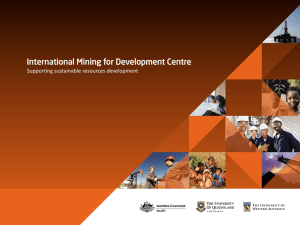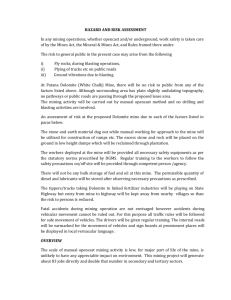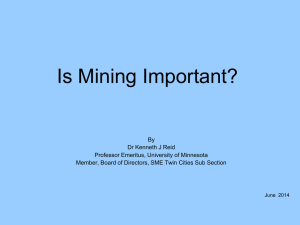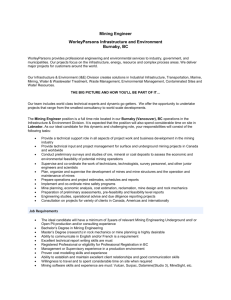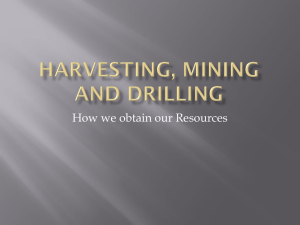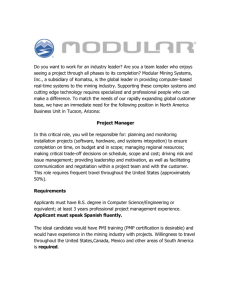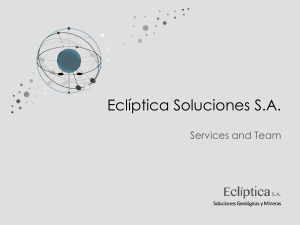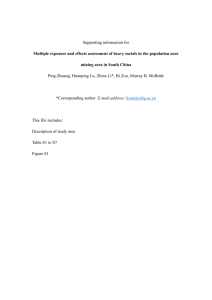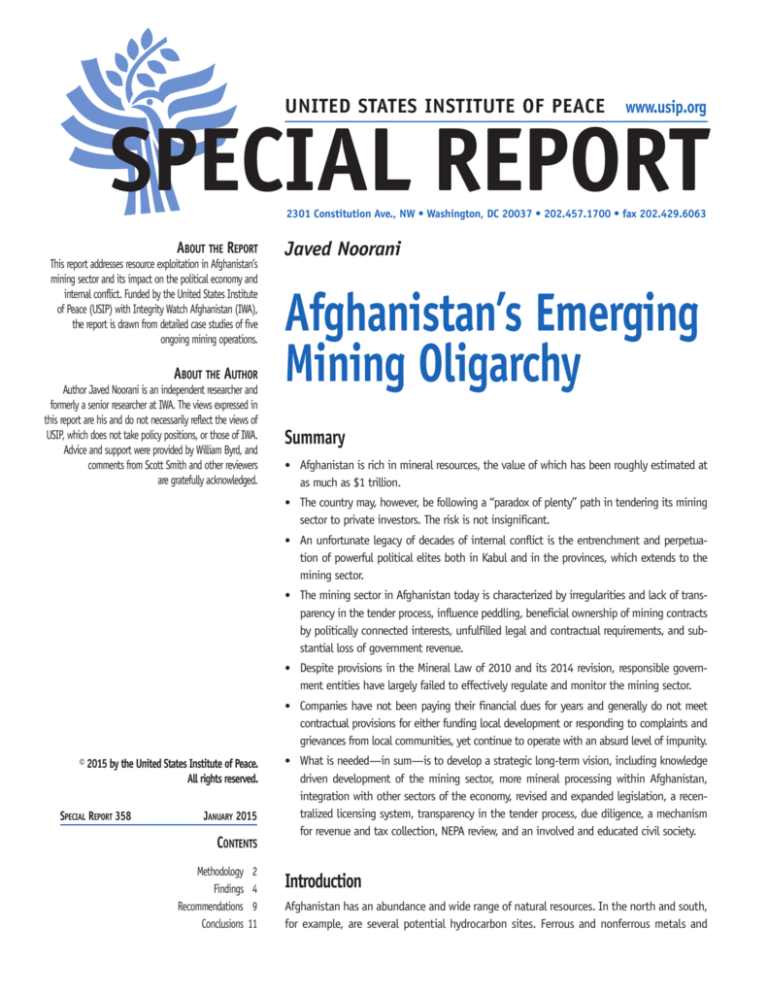
UNITED STATES INSTITUTE OF PEACE
www.usip.org
SPECIAL REPORT
2301 Constitution Ave., NW • Washington, DC 20037 • 202.457.1700 • fax 202.429.6063
About the Report
This report addresses resource exploitation in Afghanistan’s
mining sector and its impact on the political economy and
internal conflict. Funded by the United States Institute
of Peace (USIP) with Integrity Watch Afghanistan (IWA),
the report is drawn from detailed case studies of five
ongoing mining operations.
About the Author
Author Javed Noorani is an independent researcher and
formerly a senior researcher at IWA. The views expressed in
this report are his and do not necessarily reflect the views of
USIP, which does not take policy positions, or those of IWA.
Advice and support were provided by William Byrd, and
comments from Scott Smith and other reviewers
are gratefully acknowledged.
Javed Noorani
Afghanistan’s Emerging
Mining Oligarchy
Summary
• Afghanistan is rich in mineral resources, the value of which has been roughly estimated at
as much as $1 trillion.
• The country may, however, be following a “paradox of plenty” path in tendering its mining
sector to private investors. The risk is not insignificant.
• An unfortunate legacy of decades of internal conflict is the entrenchment and perpetua-
tion of powerful political elites both in Kabul and in the provinces, which extends to the
mining sector.
• The mining sector in Afghanistan today is characterized by irregularities and lack of trans-
parency in the tender process, influence peddling, beneficial ownership of mining contracts
by politically connected interests, unfulfilled legal and contractual requirements, and substantial loss of government revenue.
• Despite provisions in the Mineral Law of 2010 and its 2014 revision, responsible govern-
ment entities have largely failed to effectively regulate and monitor the mining sector.
• Companies have not been paying their financial dues for years and generally do not meet
contractual provisions for either funding local development or responding to complaints and
grievances from local communities, yet continue to operate with an absurd level of impunity.
© 2015 by the United States Institute of Peace.
All rights reserved.
Special Report 358
January 2015
Contents
Methodology
Findings
Recommendations
Conclusions
2
4
9
11
• What is needed—in sum—is to develop a strategic long-term vision, including knowledge
driven development of the mining sector, more mineral processing within Afghanistan,
integration with other sectors of the economy, revised and expanded legislation, a recentralized licensing system, transparency in the tender process, due diligence, a mechanism
for revenue and tax collection, NEPA review, and an involved and educated civil society.
Introduction
Afghanistan has an abundance and wide range of natural resources. In the north and south,
for example, are several potential hydrocarbon sites. Ferrous and nonferrous metals and
About the Institute
The United States Institute of Peace is an independent,
nonpartisan institution established and funded by Congress.
Its goals are to help prevent and resolve violent conflicts,
promote postconflict peacebuilding, and increase conflict
management tools, capacity, and intellectual capital
worldwide. The Institute does this by empowering others
with knowledge, skills, and resources, as well as by its direct
involvement in conflict zones around the globe.
Board of Directors
Stephen J. Hadley, (Chair), Principal, RiceHadleyGates, LLC,
Washington, DC • George E. Moose (Vice Chair), Adjunct
Professor of Practice, The George Washington University, Washington, DC • Judy Ansley, Former Assistant to the President and
Deputy National Security Advisor under George W. Bush, Washington, DC • Eric Edelman, Hertog Distinguished Practitioner
in Residence, Johns Hopkins School of Advanced International
Studies, Washington, DC • Joseph Eldridge, University Chaplain
and Senior Adjunct Professorial Lecturer, School of International
Service, American University, Washington, DC • Kerry Kennedy,
President, Robert F. Kennedy Center for Justice and Human
Rights, Washington, DC • Ikram U. Khan, President, Quality Care
Consultants, LLC., Las Vegas, NV • Stephen D. Krasner, Graham
H. Stuart Professor of International Relations at Stanford
University, Palo Alto, CA • John A. Lancaster, Former Executive
Director, International Council on Independent Living, Potsdam,
NY • Jeremy A. Rabkin, Professor of Law, George Mason
University, Fairfax, VA • J. Robinson West, Chairman, PFC
Energy, Washington, DC • Nancy Zirkin, Executive Vice
President, Leadership Conference on Civil and
Human Rights, Washington, DC
Members Ex Officio
John Kerry, Secretary of State • Chuck Hagel, Secretary of
Defense • Gregg F. Martin, Major General, U.S. Army; President,
National Defense University • William B. Taylor, Acting
President, United States Institute of Peace (nonvoting)
The views expressed in this report do not necessarily
reflect the views of the United States Institute of Peace,
which does not advocate specific policy positions.
To request permission to photocopy or reprint materials,
e-mail: permissions@usip.org
strategic minerals may give Afghanistan a particular advantage in attracting international
investment. Gold, platinum, silver, copper, iron, chromite, tantalum, lithium, uranium, and
aluminum have serious potential for economic exploitation. The country also has massive
deposits of dimension stone, including rare white, orange, and green onyx and more than
sixty other varieties, as well as a rare blue stone called Afghanite, which was discovered
in 1968 in Badakhshan by German geologists. Afghanistan’s emeralds, rubies, tourmaline,
aquamarine, amethyst, some types of sapphires, turquoise, and lapis lazuli have long
charmed gemstone markets and dealers alike. Overall, the value of the country’s underground
resources has been roughly estimated at as much as $1 trillion, but their true extent is
unknown because they remain largely unexplored.
However, Afghanistan may be taking a dangerous path in tendering its mining sector to
private investors. There is substantial risk that the country may become yet another example
of the resource curse that affects so many and especially low-income countries with sizable endowments of depletable natural resources.1 Of more than three hundred mining and
hydrocarbon contracts, a great number may have been exploited by local strongmen under
the protection of warlords or awarded through political influence in exchange for cash, election favors, or various other kinds of support.
Methodology
The five mines studied are Ghori Cement (cement, coal, and cement raw materials), Nuraba
and Samti (gold), Qara Zaghan (gold), Kohi Safi (chromite), and Western Garmak (coal). These
resources can be extracted without very large capital and highly advanced technological
inputs, which would require involvement by international mining companies.2 The operations
are at different stages in their life cycles, and contracts were awarded at various times between
2007 and 2012. The five mines were selected to provide some variation in geographic location,
minerals being extracted, timing within the period, and companies involved and their political
connections and networks. Table 1 provides basic information on the case studies, and map 1
shows their geographic locations in four provinces of Afghanistan.
The project entailed in-depth interviews with a diverse set of respondents as well as considerable desk research to understand the existing and applicable laws, regulations, policies,
standards, the five contracts, and various reports on the mines. This approach was necessary
to identify deviations and violations during the contracting phases as well as during project
implementation. Seventy interviews were conducted with a diverse set of stakeholders and
resource persons in Kabul, Parwan, Baghlan, Samangan, and Takhar provinces.3 The objective
was multifaceted: to better understand the political connections and beneficial ownership
of each of the mines, to highlight characteristics of the players in the sector, to determine
how contracts were tendered and awarded, and to learn both how contract implementation
and operations were occurring on the ground and the attitudes of local people toward the
mines and perceived benefits and costs to them.4 Starting from a few interviews, snowball
sampling was used to identify further key informants for interviewing.5 Some respondents
were interviewed several times because they were in a position to clarify issues and provide additional information. The findings and information from each interview were crosschecked for verification and authentication.
2
USIP.ORG • SPECIAL REPORT 358
Table 1. Basic Information on Five Mining Projects
Company
Mine
Product
Province
Year
Area
Deposit
Royalty rate
Afghan Investment
Company
Ghori Cement
(Karkar-Dodkash)
cement
and coal
Baghlan
2007
216 hectares
unknown
$1.04 / ton of cement;
$8 / ton of coal
Westland General
Trading
Nuraba and Samti
gold
Takhar
2008, 2012
1,400 hectares
Nuraba:
800 kilograms;
Samti:
31 tons (impure)
20 percent of
London Metal
Exchange Price (LME)
Afghan Krystal
Natural Resources
Qara Zaghan
gold
Baghlan
2011
1,257 hectares
unknown
26 percent of LME
Hewad Brothers
Kohi Safi
chromite
Parwan
2011
5,400 hectares
unknown
26 percent based
on $210 per ton
Khoshak Brothers
Western Garmak
coal
Samangan
2012
650 hectares
unknown
$21/ton
Source: Author’s compilation
Documentary evidence was carefully reviewed and incorporated in the analysis: contracts
for all five mines, which are in the public domain;6 relevant Afghan laws, regulations, policies,
standards, and so on;7 available reports on the mines by the government, companies, or others; and press and media accounts where relevant. Data analysis started early during the data
collection process to inform the question guide for interviews as well as to investigate emerging themes. Analysis continued after data collection was completed. Triangulation was used
to check and confirm accuracy of information. Evidence from different sources was carefully
cross-checked and cross-confirmed to derive findings and conclusions.
Map 1. Afghanistan Mine Locations
Nuraba and Samti
gold mine
Western Garmak coal
Balkh
Takhar
Kunduz
Badakshan
Baghlan
Qara Zaghan gold mine;
Ghori cement
Samangan
r
shi
Sar-e Pul
j
Pan
Bamyan
Ka
Parwan
Wardak
pi
sa
Kabul
Kohi Safi chromite mine
USIP.ORG • SPECIAL REPORT 358
3
The case study approach yields in-depth insights into what has been happening on (and
under) the ground. This study, however, also captures patterns and trends across the mining
sector more generally. Separate studies on a number of other mines reinforce and confirm the
generalizations drawn from the five case studies covered here. Amid the diversity that characterizes Afghanistan’s extractive industries sector, common features appear to characterize much if
not most mining activity related to medium-sized and fairly easily extractable resources that the
Ministry of Mines and Petroleum (MoMP) has contracted to Afghan companies.
Findings
The contracting process and the implementation of contracts as it has been unfolding provide
a useful framework for categorizing the main findings of this research. Specific findings are
organized under eight headings (corresponding to stages in the contracting process and in
implementation). Some findings concern relationships with local communities and conflicts
associated with the mines.
Tender documents
Government sources stated on
condition of anonymity that
the winners of the Qara Zaghan,
Western Garmak, and Nuraba
and Samti contracts were decided
before the tender documents
were released.
Tender documents for most of the case study mines were drafted in a way to give a certain
edge to the winner.8 The one for Ghori Cement, for example, gave a big margin to Afghan
Investment Company (AIC).9 Furthermore, in some respects certain contracts were in clear
breach of Afghanistan’s Mineral Law. The documents for the Qara Zaghan gold mine, Kohi Safi
chromite mine, Nuraba and Samti gold mine, and Western Garmak coal mine were drawn up by
MoMP officials after meeting the heads of the winning companies.10 There are also other signs
of influence peddling when tender documents were prepared. Government sources stated on
condition of anonymity that the winners of the Qara Zaghan, Western Garmak, and Nuraba and
Samti contracts were decided before the tender documents were released.11 The contest over
the chromite mine in Kohi Safi, according to a senior MoMP member, was heated, involving two
powerful individuals backed by strong networks. It led to an exchange of threats between the
two networks before Hewad Brothers was declared the winner.12
Tender process
Exertion of political influence, which started before tender documents were issued, continued through the long-listing and short-listing period. Ghori Cement is a notable example of
political interference because respective brothers of the former president and deceased first
vice president of Afghanistan, along with other politically connected businessmen, united to
win the contract.13 They influenced the process to the extent that the minister of mines at
the time reportedly lost his position for refusing to make the process easy for the company.
A report published by the Afghanistan Analysts Network in 2011 was explicit:
Former AIC investor Dawi says the president himself was involved in the decision-making.
“Mahmud Karzai talked to the president and they agreed to give this contract to the
Afghan Investment Company,” Dawi says, adding that this was to ensure that it would
go to an Afghan-owned company to support the private sector and economic growth in
the country. According to him, competing companies like the firm Aria Zamin owned by
the former minister of agriculture, Obaidullah Ramin, agreed to buy shares of AIC and
withdraw their bids. In contrast to this, the then minister of mines Ibrahim Adel told
media at the time that Aria Zamin had put in a bid but did not meet the criteria.14
In the other four cases, the winning company influenced the tendering process through
political connections or cash. Qara Zaghan reportedly involved reciprocation for a favor
extended during the 2009 presidential election.15 Kohi Safi reflected pressure from a major
power-holder. Nuraba and Samti reportedly was awarded to a friend in return for a share in the
4
USIP.ORG • SPECIAL REPORT 358
financial benefits from the mine. Western Garmak reportedly involved use of political power,
pressure, and financial favors to a former minister of mines.16
Bids submission and evaluation
That information was shared with the winning companies before tendering is reflected in
the proposal of each company. Promises of huge royalty payments, ambitious commitments
for extraction of minerals sometimes in the absence of exploration data, and promises of
employment opportunities for Afghans and other revenue generation seemingly trapped even
noncorrupt state officials into selecting the winning bidder. Afghan Krystal Natural Resources
(AKNR), which won the Qara Zaghan gold contract, promised to pay 26 percent royalty on gold
to the government, taking the London Metal Exchange price as base. Hewad Brothers, winner
of the Kohi Safi chromite contract, also promised to pay 26 percent. Westland General Trading
committed to pay 20 percent for the Nuraba and Samti gold mine. Khoshak Brothers agreed
to pay Afs 1,211 (approximately $21) per ton of coal. On the other hand, Ghori Cement was
contracted to AIC for a royalty of $1.04 per ton of cement (to cover the exploitation of raw
materials, such as limestone, clay, and gypsum).17 The coal AIC used for production of cement
was to be charged $8 per ton of fixed royalty which is a highly favorable rate for the company.18
Other than for Ghori Cement, the royalties promised by the winning bidders were high and
undoubtedly influenced the scoring behavior of the officials evaluating the bids for each mine.
Promised royalties did not materialize, however.
Contracts and contradictions with the law
The Mineral Law of 2010 under its Eligibility Article prohibits politicians and senior government officials from acquiring any mining contract, yet in all five case studies there appear to
be examples of beneficial ownership on the part of such persons or their close relatives, often
hidden. As noted earlier, in the case of Ghori Cement, owners included the brothers of both
the former president of Afghanistan and the deceased former first vice president. The company
extracting chromite at the Kohi Safi mine reportedly belongs to a member of parliament. The
Qara Zaghan gold mine is contracted to a family that has three elected representatives in the
parliament. The Nuraba and Samti gold mining contract was awarded to a man who previously
had a chromite contract in Khost and was reported officially for smuggling19 and reportedly is
in partnership with the current head of the lower house of the parliament. Under the Mineral
Law, his company would be ineligible for further contracts because his contract was terminated
before the contract completion date.20 The Western Garmak coal mine is owned by a member
of the Wolesi Jirga.21 These ownership relations are in serious contradiction to the Mineral Law,
or—when close relatives are involved rather than politicians and officials themselves—may not
be outright illegal but clearly reflect the high-level political connections and networks involved.
Meeting legal requirements
The Mineral Law and the Environment Law require mining companies to conduct a social
and environment impact study before beginning extraction. All five contracts allowed each
operator between one and three years for exploration, preparation of an Environmental
and Social Impact Report (ESIR), feasibility study, and environment protection plan. Mine
operators in all cases are required to submit their exploration plan to the MoMP first for
approval and then are expected to submit their findings and the various studies before an
exploitation license is granted. The ESIR is an important document that should be submitted
before any extraction occurs. None of the five companies have fulfilled any of these legal
and contractual requirements.
USIP.ORG • SPECIAL REPORT 358
5
The Qara Zaghan gold mine is
contracted to a family that has
three elected representatives in
the parliament
Mine safety also has been largely ignored by the companies, which tend to unfairly subject
their employees to long working hours and low wages. AIC, for example, retired many of the
employees of the Cement Ghori public sector enterprise it took over without paying their pensions.22 Three of the company’s workers died in the coal mine AIC is operating. Workers at the
Western Garmak coal mine are paid Afs 400 (about $7) as daily wages while being exposed to
fatal risks. Two workers were trapped in the mine, for example, and one died after a long wait
for first aid because of the lack of adequate medical facilities at the site.
Contract implementation
Khoshak Brothers was given
three years for exploration at
the Western Garmak coal mine
but has already been engaged in
extraction for the past year in the
absence of any map or exploration
data presented to the MoMP.
The most serious contract breaches and violations have occurred at the implementation
stage.23 In the case of Ghori Cement, AIC carried out exploration for neither the cement
plant nor the coal mine but immediately began extracting coal for direct sale (rather than
for cement production as called for in the original contract). A 2011 publication noted, “Five
years ago, the Ghori cement factory in Baghlan turned into a symbol of corruption, when the
lease for the formerly state-run enterprise was granted to the Afghan Investment Company
(AIC) run by Mahmud Karzai, a brother of the president.”24
At Qara Zaghan, even though the company promised to extract a sizable amount of gold
in the first year and pay related royalties, AKNR was given three years for exploration, feasibility study, environmental and social impact study, and environment management plan. The
company, however, started extracting resources immediately but did not pay any royalties
and recently—four years later—applied for cancellation of the project on the grounds that
the mine has no gold deposits.25 Senior officials of the MoMP stated that AKNR did not
share its exploration plan and the MoMP did not approve it. Moreover, the exploration report
presented to the MoMP in September 2012 was not a report of its activities but instead a
translation of old Russian reports from the 1980s.26
The Westland General Trading Company is purportedly still engaged in exploration, many
years after being awarded the concession for the Nuraba and Samti gold mines. It has failed
to produce maps, ESIR, data, and estimates despite—contrary to the contract provisions—
confirmed reports of extraction occurring.27 Hewad Brothers, awarded three years for exploration,
ESIR, feasibility study, and environment management plan, began extracting chromite ore in the
first week after signing the contract, continued extracting for three years until it was stopped
from doing so by armed groups, and has submitted no reports to the MoMP. Khoshak Brothers was
given three years for exploration at the Western Garmak coal mine but has already been engaged
in extraction for the past year in the absence of any map or exploration data presented to the
MoMP. It has also not produced an ESIR or safety and security manual for the mine.
In addition, companies have tended to use modes of extraction that can be expected to
reduce the long-term revenue potential and overall development benefits for Afghanistan
of the reserves contracted to them. As noted earlier, AIC has been selling Ghori Cement
coal on the open market rather than investing in production of cement and using the coal
as raw material for that effort. Hewad Brothers, contrary to the provisions of the Kohi Safi
contract, has engaged in only minimal processing of mined chromite ores before selling
them for processing in Pakistan.28 Westland General Trading Company has reportedly been
extracting gold from the more easily and inexpensively exploitable part of the gold reserves
at Nuraba and Samti rather than taking on the more difficult and costly gold ores, though
the contract called for balanced mining of both.29 Given that their extraction activities
in any case were contrary to contractual and legal stipulations, the companies apparently
have been taking the easiest path to quick profits to the detriment of overall development
benefits and longer-term revenue potential.
6
USIP.ORG • SPECIAL REPORT 358
In sum, all five companies have been extracting resources to generate quick and easy
profits while for the most part still purportedly engaged in exploration without providing
necessary documentation to the MoMP, obtaining the ministry’s permission for exploitation,
or paying required royalties and taxes.
Changes in contracts
Changes have been made to signed contracts without following stipulated procedures or
providing public transparency. This continues the exertion of political influence evident in
earlier stages of the tendering and contracting process. AIC separated the coal mine contract
from the main cement contract and assumed the right to sell the coal it extracts, on which
the royalty rate is very low, on the open market. Moreover, AIC has been let off the hook on
its commitment to build a third cement factory with three thousand ton per day capacity.
AKNR promised in its tender bid to start production of gold within six months but got
an exploration license for three years and then an extension for two additional years. In its
proposal, the company had indicated that it would produce 1,628 kilograms of gold every
year, whereas in the contract it secured a three-year exploration period without any immediate commitment to produce gold and pay royalties. The company has also transferred its
rights over Qara Zaghan to Afghan Gold and Mineral Company without informing the public.
Westland General Trading Company signed a new contract five years after extracting
under a 2008 license, securing more time for exploration without providing data from the
previous work as well as a reduced royalty rate. Hewad Brothers managed an extension for
their exploration work and the base price for royalty reduced from $210 to $170.
Monitoring of operations and contract implementation
The MoMP and the National Environmental Protection Agency (NEPA), mandated to regulate
and monitor mining operations, have largely failed in executing their responsibilities. NEPA
to date has not received an ESIR from any of the five companies, which suggests that the
agency has been rather passive. The companies continue to operate, however. The MoMP
inspection department has not effectively inspected the operations to assess production
levels or the installation of equipment and gear for safety conditions. Incidents have
occured of explosions at AIC-run coal mines as well as at the Western Garmak coal mine,
but the MoMP has neither reported them nor investigated the cases. The MoMP cadastre
department has neither received the payments due from all five mines nor pursued them to
make required payments.
Lack of accountability for contract requirements
The Mineral Law defines a few clear red lines in terms of violations but does not say much
about penalties. Some contracts state that certain situations will incur penalties, but the
penalties are not defined. The law and contracts mention circumstances for cancellation
and ineligibility, but this has not yet happened. Most of the violators are operating mines
with an absurd level of impunity. Companies have not been paying their financial dues
for years, yet they are continuing to operate without any adverse consequences. Hewad
Brothers has not yet paid any royalty.30 Westland General Trading under the Afghanistan
Extractive Industries Transparency Initiative reporting requirements shows a payment of
about $240,000 as nontax revenue payments for the year 2011–12,31 but no other. Ghori
Cement has not paid $1 million in rent.32 Khoshak Brothers have been extracting coal but
have avoided paying full dues.
USIP.ORG • SPECIAL REPORT 358
7
Companies have not been paying
their financial dues for years, yet
they are continuing to operate
without any adverse consequences.
Hewad Brothers has not yet paid
any royalty. Ghori Cement has not
paid $1 million in rent. Khoshak
Brothers have been extracting coal
but have avoided paying full dues.
Relationships and conflicts with local communities
Contractual provisions for funding local development in the areas around the mines and
responding to complaints and grievances of local communities have generally not been followed. Some of the mine operators in their proposals have committed to providing tens of
thousands of dollars for local development but have not delivered on those commitments. For
example, Hewad Brothers committed to spend $20,000 for the development of local communities but so far has not spent anything for this purpose. AKNR committed to spend $50,000 but
has spent the money on construction of housing for its security personnel instead.
Sometimes conflicts have been precipitated or exacerbated by the mining activities.
Despite instances of violence and deaths, the government has not reminded companies of
their contractual obligations. Active conflict over the chromite mine in Kohi Safi has already
resulted in nineteen deaths.33 Groups are maneuvering to counter each other, and weaker
local communities have invited Taliban elements to protect them, strengthening the insurgency’s position close to Kabul. Intimidation has been exercised and violence has broken
out related to Qara Zaghan and local opposition to that mine inflicted. Pressure has been
applied on the Western Garmak coal mine and Nuraba and Samti gold mine to silence the
local populations. Local artisanal miners who extracted coal before the contract was given
to Khoshak Brothers protested against the company but were silenced through a combination
of police pressure and local elders’ involvement.34 Local residents protested against Westland
General Trading for not fulfilling its promises, but the government intervened and quieted
the protesters.35
In some mines, the company or associated local power-holders have managed to get
members of their militias recruited into the Afghan Public Protection Force (APPF) under the
Ministry of Interior, which is responsible for providing security at mine sites. These forces
have also been used, however, to suppress local communities’ efforts to air grievances and
assert their rights. Sometimes who gets recruited into the APPF, with associated jobs and
benefits, has become a trigger of violence, as in Kohi Safi.
Revenue losses to the state
Estimated total lost revenues from
the five mines, compared with
their revenue potential, are more
than $50 million annually from
just two revenue streams
(royalty and surface rent).
Extractive industries are widely seen as a good source of revenue for the state, and the primary
reason for awarding these five mining contracts—as well as many others throughout Afghanistan—was precisely that. Mining revenues will be particularly important in coming years, given
the weakness of other revenues and that international aid will continue to decline.
However, corruption and abuse of political connections in all five mines have led to sizable forgone revenues. Estimated total lost revenues from the five mines, compared with their
revenue potential, are more than $50 million annually from just two revenue streams (royalty
and surface rent). These estimates are based on production levels promised or estimated by the
companies in their bids along with contractual royalty rates. The study could not fully capture
the amounts of other taxes evaded by each company, but undoubtedly these losses were substantial as well.36 Table 2 presents the estimated royalty and surface rent payable by the five
mines. Given the more than three hundred contracts awarded by the MoMP, and even more by
provincial mining departments, the total loss of government revenue from royalty and surface
rent easily could be hundreds of millions of dollars annually.
8
USIP.ORG • SPECIAL REPORT 358
Table 2. Estimated Annual Royalty and Rent Due
Company
Promised/Estimated Production
Hewad Brothers (chromite)
AIC (coal)
Royalty Due in $
Surface Rent in $
130,000 tons
7,098,000
67,500
1,000,000 tons
8,000,000
300,000
AIC (cement)
438,000 tons
455,520
1,000,000
AKNR (gold)
1,628 kilograms
17,883,898
31,425
Khoshak Brothers (coal)
Westland General Trading (gold)
Total
88,110 tons
1,894,365
16,250
1,700 kilograms
15,591,040
15,000
53,663,572
1,430,175
Source: Author’s compilation based on information in each contract (including royalty rates in table 1), production
levels promised or estimated in company bid proposals, and international websites. The price of gold for these
calculations is taken as $45,856 per kilogram (based on www.usagold.com/dailyquotes.html). The price of coal used is
$90 per ton (taken from traders involved in the coal trade). The production level for AKNR is taken from the website of
the MoMP, where the bids of the three companies competing for the Qara Zaghan contract were shown.
Recommendations
These recommendations are directed at the various key stakeholders engaged in, overseeing, or affected by exploitation of Afghanistan’s underground mineral resources in different
ways. Ideally, the recommendations will help facilitate a constructive dialogue for making
improvements in the regulation of the mining sector and in particular for ensuring that
revenues due to the government are neither lost nor diverted into private pockets.
Ministry of Mines and Petroleum
The government should formulate a strategic vision for the development of the mining sector and avoid being trapped by a quest to generate quick revenues without putting effective
institutions and proper regulations in place. The international community can be a supporting
partner in this endeavor. The vision needs to be realistic, based on sound principles, and geared
toward equitable, sustained long-term development, including more mineral processing within
Afghanistan and integration with other sectors of the economy.
The MoMP needs to amend the current revised Mineral Law of 2014, which was only recently
approved by the Wolesi Jirga and signed by the president. The law lacks provisions necessary
to guard against corruption and cannot bring stability to the currently chaotic mining sector in
the country. The law and regulations should define more specific penalties for companies and
individuals either deviating from the terms of contracts or resorting to illegal extraction and
nonpayment of royalties and other dues. The revised law should undergo meaningful consultations before being finalized and sent to the cabinet and parliament for ratification.
The new Afghan administration needs to recentralize the licensing system for mines. The
decentralization of licensing for smaller mines to provincial mining departments has led to
even greater corruption and secrecy. Contracts for extraction have been awarded without
any revenue coming to the government. In dozens of cases, contracts have been awarded to
powerful members of parliament, warlords, and other politicians.37 The MoMP compiled a list
of illegal extraction at 1,400 sites, and sources within the MoMP stated that the majority of
them are being operated by powerful people.38 The government should declare the unlicensed
extraction of chromite, coal, and both precious and semiprecious stones illegal and subject to
penalty or punishment.
Tender documents must make it mandatory for bidders to disclose of the beneficial ownership of each company and the names of all its shareholders. Doing so is essential to avoiding
the phenomenon of hidden owners, shareholders, and beneficiaries, including senior government officials and powerful political players, whose involvement in the companies concerned
clearly gives an impression of unfair granting of favors and quid quo pros.
USIP.ORG • SPECIAL REPORT 358
9
The law and regulations should
define more specific penalties
for companies and individuals
either deviating from the terms
of contracts or resorting to illegal
extraction and nonpayment of
royalties and other dues.
The bidding process must be
transparent, and all proposals as
well as the contract itself should
be made public after signing
the final contract with
the winning entity.
Serious due diligence must be carried out on each company bidding for mines in Afghanistan before it is considered technically qualified and is shortlisted for evaluation of bids for
mining concessions. The experience of the company—especially in mining—its technical and
financial capacity, mining expertise, shareholders’ profile, operation methods, and access to
technology need to be studied. Mining investments by suspect entities, including domestic
as well as foreign companies especially from Afghanistan’s neighborhood, cannot be allowed.
The tendering, shortlisting of each bid, bid evaluation, and negotiation should be carried
out by a team that includes knowledgeable experts, has clear benchmarks and accountability, and is insulated from political interference. The final contract should reflect the commitments made in the proposal submitted in response to the tender document. The bidding
process must be transparent, and all proposals as well as the contract itself should be made
public after signing the final contract with the winning entity. Transparency is essential to
safeguarding against political interference and ensuring that the best offer for the country
is the one that is accepted.
Clear definitions of the various activities in the mining sector need to be established (for
example, exploration versus exploitation), and companies need to be regularly monitored as to
whether their activities conform to those stipulated in their contracts. Most important, when
there is a shift from exploration to exploitation, it needs to be confirmed that the requirements
for this change—stipulated in the law, regulations, and contract—have been met.
Ministry of Finance and MoMP
The MoMP and the Ministry of Finance (MoF) should develop a joint mechanism for collecting
revenues on due dates from each company and share information on collections with the
public. This would help in capturing the rent owed to the state, and the public would be
informed as to how much revenue has been collected from the sector.
The MoMP and MoF should create a joint team to assess and monitor the revenue-generating activities of each company at each stage that revenue for the government is supposed to
accrue. The MoMP should review the timeline for each company as specified in the contract,
inspect their activities, and ascertain whether their activities correspond with the timeline.
This would prevent overextraction or production occurring while taxes and other rents are
being denied to the state.
The MoF’s Customs Department should be provided a copy of each mining contract and
track the exports of each company so that these can be cross-checked against contractual
and legal requirements. This would help to ascertain both who is exporting how much and
the amount of Afghanistan’s annual export of minerals, which may help in reducing vulnerabilities to corruption.
The MoF and MoMP should work on developing a mechanism to project, based on the
contract provisions, the revenue expected from each mine and to monitor the actual collection of revenue. In this way, shortfalls and delays in revenue collection can be identified and
reviewed, and the reasons for them assessed and remedies devised depending on the cause.
National Environment Protection Agency
NEPA should independently require companies to turn over to it the required ESIR and should
review the ESIR before issuing an exploitation permit. The decision in each case should be
published on NEPA’s website, which will increase access to information and awareness of
citizens, in particular those living in communities around mines.
The inspection department of NEPA should clearly define the processes involved in mining
operations and regularly monitor and inspect adherence to the same by mining operators. This
would help encourage companies to follow standard procedures and reduce the risk of inci10
USIP.ORG • SPECIAL REPORT 358
dents. Inspections should be standardized for mining processes and for equipment for mine
operation, and NEPA needs to inspect mines regularly and share its reports with the public.
NEPA should also carry out thorough environmental baseline studies of the environment
in areas where mines are located. This will enable NEPA to assess the environment management plans of mine operators in an informed manner.
Ministry of Interior
The APPF should protect mining sites from subversive elements but not interfere in disputes
between communities and companies over rights-based issues. Recruitment into APPF units
protecting mines must not be from militias associated with the mining company or related
power-holders. APPF personnel guarding mining sites need to be trained in human rights
issues and other international standards before deployment.
Afghan Civil Society
Civil society needs to educate itself more on natural resource governance, revenue management, and social and environmental impacts associated with mining to be effective in
related advocacy, monitoring, and mobilization work. Achieving change in the sector will
require consistent and synergistic efforts. Civil society should carry out more research, both
on individual mines and on broader patterns of tendering and contract implementation,
revenue collection, and management to more soundly base its advocacy efforts on solid
evidence. Such efforts may help bring about policy changes, inform citizens, and improve
revenue management in the sector.
International Partners
The international donor community needs to provide targeted funding to the MoMP. For
example, some focus needs to be on the exploration of unexplored mineral reserves to confirm their size and potential exploitability. Selective upstream exploration sponsored by the
public sector may also be helpful in curbing tendencies of mining companies to engage in
exploitation under the guise of exploration. This may also help less corrupt mining companies to invest more in the midstream mining activities which involve development of a mine
site for exploitation, leading to higher production and revenues for the state.
The international community should help the government develop the sector rather than
push for overly rapid extraction in the short run. Nurturing good governance needs to play
an important role in this regard. Moreover, international partners may help both in developing a good strategy for governance of the sector and in providing technical and financial
support for capacity building and implementation of the strategy. Last but not least,
international partners can play an important role in helping ensure sound environmental
management and mitigation of adverse environmental impacts of mining activities.
Conclusions
The legacy of the past several decades of Afghanistan’s conflict and the associated war
economy has been the entrenchment and perpetuation of powerful political elites both in
Kabul and in the provinces. The power configuration in the center and provinces shows the
footprints of these political and armed forces at the helm of governance. The availability of
easily exploitable mineral resources and prospects for easy money and windfall rents from
the sector have led political elites to exploit weak and corrupt government institutions.
These elites appear to be increasingly using state institutions to distribute resource rents
among themselves and their clients, and sometimes contest over them as well. In a worstUSIP.ORG • SPECIAL REPORT 358
11
The international community
should help the government
develop the sector rather than
push for overly rapid extraction
in the short run.
case scenario, elites may mobilize their armed groups to capture and exploit mines and thus
promote a kind of balkanization of parts of the country in the wake of the withdrawal of
international troops.
The development discourse within Afghanistan around the mining sector has sometimes
been imbued with intense nationalistic rhetoric, ostensibly to discourage the takeover of the
country’s rich resources by foreign private investors and instead to provide opportunities for
Afghan businesses. This rhetoric, however, may just pave the way for the capture of resources
by Afghan elites and their cronies, preventing more responsible exploitation by companies that
have greater technical expertise and are subject to more stringent financial, environmental,
and labor regulations in their home countries. As a result, political elites may become further
entrenched and be in an even better position to perpetuate themselves using the gains from
lucrative mining resources. This situation has adverse political economy implications as well as
conflict risks. Moreover, these trends, if they take root, may lead to serious questions about
the resulting, highly unequal distribution of wealth in the country as well.
Finally, exploiting mineral resources without paying associated taxes and royalties has
major adverse consequences for Afghanistan’s budget revenues. This study estimates the revenue loss compared with potential revenues at more than $50 million annually for the five case
study mines from only two revenue sources (royalties and surface rent). The total loss from all
revenue sources for the three hundred plus mines contracted by the MoMP easily could be hundreds of millions of dollars per year. The country can ill afford such revenue losses, particularly
when the need for budget revenues is greater as international aid declines.
12
USIP.ORG • SPECIAL REPORT 358
Notes
1.
2.
3.
4.
5.
6.
7.
8.
9.
10.
11.
12.
13.
14.
15.
16.
17.
18.
19.
20.
21.
22.
23.
24.
25.
26.
27.
28.
29.
30.
The resource curse refers to the common pattern whereby countries with large endowments of natural resources,
in particular those that develop such resources in the absence of strong institutions for management and
accountability, suffer from slower economic growth, worse governance, sometimes problematic politics, and
higher conflict risks than would otherwise be the case. Academic debate about the resource curse and its
causes and manifestations is considerable, and the adverse effects on governance ad politics appear to be more
important than the macroeconomic distortions induced by large natural resource exports (the so-called Dutch
disease problem). For a thorough discussion, see Paul Collier, The Plundered Planet: Why We Must—and How We
Can—Manage Nature for Global Prosperity (New York: Oxford University Press, 2010). On Afghanistan, see William
Byrd, “Political Economy and Conflict Dimensions of Afghanistan’s Mineral Resources: A Preliminary Exploration,”
U.S. Institute of Peace, Peace Brief no. 137, December 17, 2012, www.usip.org/publications/political-economyand-conflict-dimensions-afghanistan-s-mineral-resources-preliminary.
Examples of much larger mineral resources that have been contracted to foreign companies include the Aynak
copper and Hajigak iron mines. However, these mines have been the subject of other major reports, and
furthermore mining activities have not begun at either. This study instead focuses on mining operations already
under way, so as to ascertain what is happening in terms of actual experience with such operations.
Given the sensitivity of the topics discussed, most interviewees understandably preferred to retain anonymity and
therefore are not cited by name.
Beneficial ownership refers to parties who reap a share of the financial benefits of a company or venture, even if
they may not be listed as formal shareholders or officers of the company.
Snowball sampling is a nonprobability sampling method, whereby the next subject is identified through the
current interviewees. The sample group grows like a snowball as one moves ahead in identifying more informants
for research.
Ghori cement contract, http://mom.gov.af/Content/files/Mineral%20Contracts/new_MX-2301N_20121013
_183416_lr.pdf; Qara Zaghan gold, http://mom.gov.af/Content/files/Mineral%20Contracts/File_211_QaraZaghan_
Contract-English.pdf; Kohi Safi chromite, http://mom.gov.af/Content/files/Mineral%20Contracts/File_206_
Gada_Khail_Chromite.pdf; Nuraba and Samti gold, http://mom.gov.af/Content/files/Mineral%20Contracts/
new_Noraba_%20Samti_Gold_lr.pdf; Nuraba and Samti second contract, http://mom.gov.af/Content/files/
Gold%20of%20Takhar%20Pronice.pdf; and Western Garmak coal, http://mom.gov.af/Content/files/Mineral%20
Contracts/File_209_West_Garmak_Coal_Contract-English.pdf.
See Mineral Law of Afghanistan, http://publicintelligence.info/AfghanMineralLaw.pdf; and Mining Regulation
of Afghanistan 2010, http://mom.gov.af/Content/files/Mining%20regulations%281%29.pdf. See also various
reports on Afghanistan’s participation in the Extractive Industries Transparency Initiative(EITI), https://eiti.
org/Afghanistan.
The tender documents for some of the contracts were for a time available on the MoMP website.
Interview with senior MoMP official involved in proposal evaluation, January 20, 2014.
Interview with senior MoMP officials, January 15, 2012.
Based on interviews with senior MoMP officials.
Based on an interview with MoMP official overseeing mine evaluation process, December 12, 2013.
In addition to interviews, press reports document the high-level political influence over the Ghori Cement contract. See
Jonathan S. Landay, “Factory, Coal Mine Show Connections Matter Most in Afghan Business,” McClatchy Newspapers,
November 14, 2010, www.mcclatchydc.com/2010/11/14/103393_afghan-business-model-connections.html?rh=1.
Mir Sediq Zaliq, “Ghori Cement—A Loss-Making Goldmine,” Afghanistan Analysts Network, July 7, 2011, www.
afghanistan-analysts.org/guest-blog-ghori-cement-a-loss-making-goldmine/.
“It [Qara Zaghan] was a political trade for the vote the president got in the 2009 presidential election” (Interview
with senior government official, September 7, 2011).
Interview with a former MoMP policy manager, January 15, 2012.
Ghori Cement contract, p. 6.
In the case of Ghori Cement, a blank contract was provided to AIC, which then could fill in provisions as it saw
fit. This was confirmed in multiple interviews, and the author has seen a copy of the signed blank contract.
Evidence of smuggling was sufficient to declare the company ineligible for future contracts.
Mineral Law of Afghanistan 2010, Article 14, Section (2)5.
The member of the Wolesi Jirga identifies himself on his business card as the president of Khoshak Brothers
Company, which he represents at various forums. Several MoMP officials confirm both roles.
A report prepared by MoMP officials noted that more than a thousand older employees of the former public
enterprise were fired and not paid their pensions. The employees protested for several months before members of
the provincial council intervened and forced the company to pay. A senior official of the mining department in
Baghlan said in an interview that Rasool Khan, a member of the provincial council, pressured AIC to pay pension
to the retired employees, and they were finally paid after many protests and complaints (December 23, 2013).
Except where otherwise cited, the findings with regard to implementation of contracts that are summarized here
are based on extensive interview responses from government officials, staff of the mining companies concerned,
and knowledgeable local people, as well as the author’s own observations during field work.
Zaliq, “Ghori Cement.”
Interview with senior Afghanistan Geological Survey official, August 12, 2014.
Interview with senior MoMP official who read the exploration report, July 14, 2014.
See the Government of Germany’s Progress Report on Afghanistan, December 2011, p. 60, www.auswaertiges-amt.
de/cae/servlet/contentblob/611546/publicationFile/165674/111214-Fortschrittsbericht2011.pdf.
Interview with senior Afghan Geological Survey geologists, January 27, 2014.
Interview with MoMP official, August 20, 2014.
Ibid., February 15, 2014.
USIP.ORG • SPECIAL REPORT 358
13
31. AEITI, Afghanistan Third EITI Reconciliation Report 1390 (2011–2012), September 2014, p. 23, https://eiti.org/
files/Afghanistan_2011_EITI_Report.pdf.
32. AEITI shows that AIC has paid nontax revenue of $31,000. Ibid.
33. One violent incident in particular was reported in local and international media. See Afghan Voice Agency,
“Roadside Bomb Kills 8 Afghan Mining Company Workers in Parwan,” September 1, 2013, http://www.ava.af/
vdcaumn0.49neu1gtk4.html; also Ana Komnenic, “Eight Mining Workers Killed in Afghan Bomb Blast,” Mining.
com, September 1, 2013, www.mining.com/eight-Mining-Workers-Killed-in-afghan-bomb-blast-72823/.
34. Interview with local resident near Western Garmak coal mine, July 18, 2014.
35. Interview with official of Baghlan Province mining department, November 17, 2013.
36. For example, these companies should have paid corporate income tax on the profits from their mining activities,
but because they did not report extraction of minerals or pay royalties, no taxable profits would have been
reported either.
37. Mehwar Daily, a Pashto newspaper, reported on November 2, 2014, that forty members of parliament are either
directly or indirectly involved in mineral extraction.
38. The list of illegal mines as compiled by MoMP was available on the Dari website of MoMP but has been removed
recently (copy in the author’s possession).
14
USIP.ORG • SPECIAL REPORT 358
ISBN: 978-1-60127-279-9
An online edition of this and related
reports can be found on our website
(www.usip.org), together with additional
information on the subject.
Of Related Interest
• Exploitation of Mineral Resources in Afghanistan Without Government Revenues or Development
Benefits by William Byrd and Javed Noorani (Peace Brief, November 2014)
• Extractive Industries and Peacebuilding in Afghanistan: The Role of Social Accountability by Sadaf
Lakhani (Special Report, November 2013)
• Political Economy and Conflict Dimensions of Afghanistan’s Mineral Resources: A Preliminary Explo-
ration by William Byrd (Peace Brief, December 2012)
United States
Institute of Peace
2301 Constitution Ave., NW
Washington, DC 20037
www.usip.org
@usip

